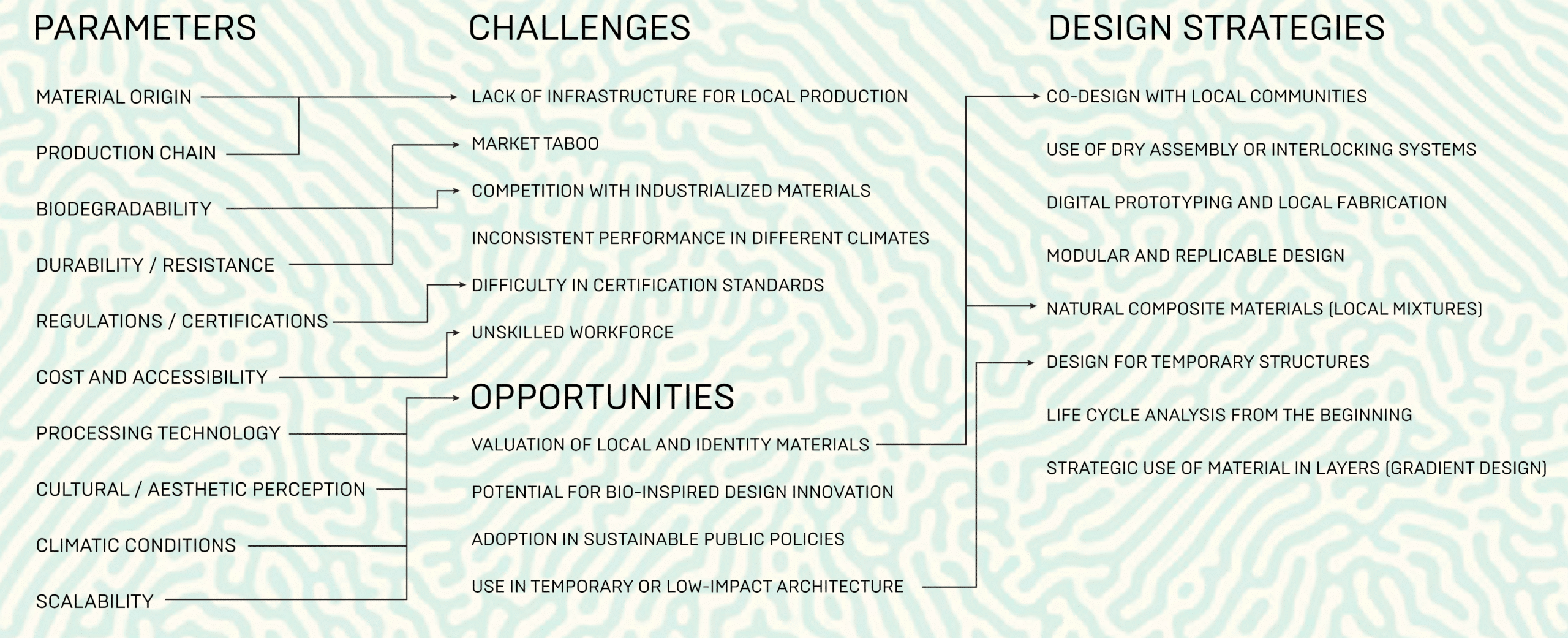Biomaterial is a concept that is already late to be implemented. In the article “Principles of biological design as a model for biodesign and biofabrication in architecture,” the ideas around the use of biomaterials in the construction sector are carefully explored and evaluated. It is stated that they are a great replacement for conventional standardized materials, offering an alternative to recyclability, reduction of carbon emissions, lower energy production, and better environmental efficiency. However, they mostly still require some sort of unconventional maintenance process, are harder to mass fabricate, and sometimes present a non-linear behavior.
The use of biomaterials is said to be directly attached to diversity. Homogenizing the use would cause a loss of biodiversity and intense degradation of a certain resource reservoir. Unlike industrialized materials, biomaterials demand a more complex form to better adapt structurally, but, on the other hand, can be more easily self-repairing and modifiable, increasing in size and changing function. In addition, this technique requires a high computational design expertise from the idealists of the project.
Even with the existing logistical challenges regarding the instantaneous implementation of bio-products in the architectural field, this is an obstacle that has to be overcome in order to aim for a more sustainable future. The biggest barrier would be cultural. A higher percentage of the field still uses large amounts of rudimentary materials mostly because it takes a long time for the labor force to be adapted, and it is still faster and cheaper to build with them in terms of financial and expertise hiring costs.
In a – not so – far future, I hope society has evolved past current practices and buildings have been rethought to incorporate biomaterials on a larger scale. For now, timber-based solutions and other regenerative materials can work as a great substitute for heavy carbon emitting structural and envelope materials like reinforced concrete and masonry; while cork can be heavily explored for facades for their thermodynamic characteristics and durability, for example. But in a far future, buildings could not only be made out of biomaterials, but be considered per se a living structure, evolving and reshaping when needed. Walls made out of bioengineered self-repairing mycelium or seashells, controlling the interior’s temperature and air quality. Bio-facades that change colors according to sunlight intake and airflow required throughout the day. Sponge-like roofing that absorbs and filters rainwater. Different types of moss could be a replacement for flooring and fabric, and creepers could be used as fins.
Biomaterials are a great ally in the fight to protect the environment and therefore maintain the status quo of a sustainable society. It is still a shy approach but have the potential to become one of the main themes around architecture and urban design in the future.
This theme is especially interesting because it challenges conventional construction norms and offers an extremely sustainable alternative to environmentally harmful practices. As climate change and resource scarcity become more intense, biomaterials offer not only ecological benefits but also open new creative and technical possibilities for architects and engineers. It’s a utopian view for now, but it may be a glimpse into a future where buildings behave more like living organisms, capable of adapting and evolving alongside their environments.

Biomaterials are versatile and have a direct relationship with all the other topics debated during the course:
Ecological Design: biomaterials are one of many strategies within ecological design. Often cultivated rather than extracted, they help reduce the environmental impact of construction. This cultivation process requires fewer destructive interventions in the environment and aligns with renewable and regenerative cycles. Some biomaterials, like mycelium or algae-based composites, go even further by actively sequestering carbon or filtering pollutants, thus contributing not only to low-impact construction but also to ecological regeneration.
Multispecies Design: biomaterials support symbiotic relationships with other species and allow architecture to participate in ecological networks. Beyond enabling microbial life or plant growth, they can structure food chains – a facade made of bioactive material may host mosses and insects, which attracts birds – thus expanding the ecological role of buildings in urban environments.
Vernacular Architecture: the contemporary use of biomaterials offers a reinterpretation of vernacular architecture, which often relies on natural materials and climate-adapted techniques rooted in local contexts. Today, this approach is revisited through modern tools like digital fabrication and bio-based composites, allowing the recovery of localized principles using materials such as pressed straw or hemp.
Adaptation and Mitigation: one of the way biomaterials promotes climate adaptation is by enabling more resilient construction solutions that rely on local, renewable resources with natural thermal performance, reducing dependence on artificial systems and increasing autonomy in the face of extreme events. In terms of mitigation, these materials replace high-carbon-footprint inputs and act as carbon sinks by incorporating biomass into regenerative production cycles, contributing to reversing climate change.
Urban Greening: living or biodegradable materials integrate naturally into green infrastructure. Their porous and organic characteristics allow for water retention, microbial activity, and plant colonization. A facade built with biomaterials, for example, can host vegetation, contribute to biodiversity, and function as an active part of an urban ecosystem, enhancing environmental performance and reconnecting architecture with living systems.
In summary, biomaterials represent a promising path toward a more sustainable and ecologically integrated built environment. While challenges remain, their potential to transform architecture into a living, adaptive, and regenerative system is undeniable. As innovation continues and awareness grows, biomaterials may well redefine the future of construction, blurring the boundaries between the natural and the built world.

